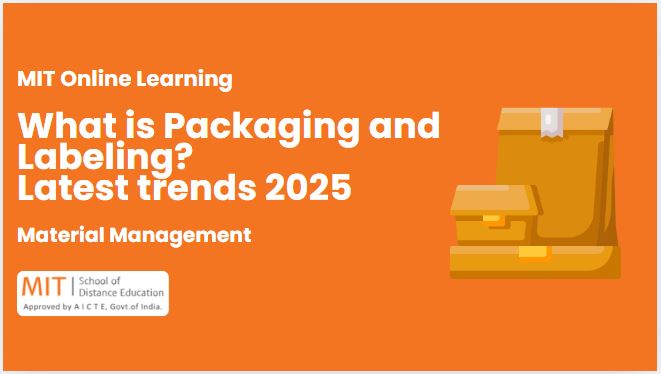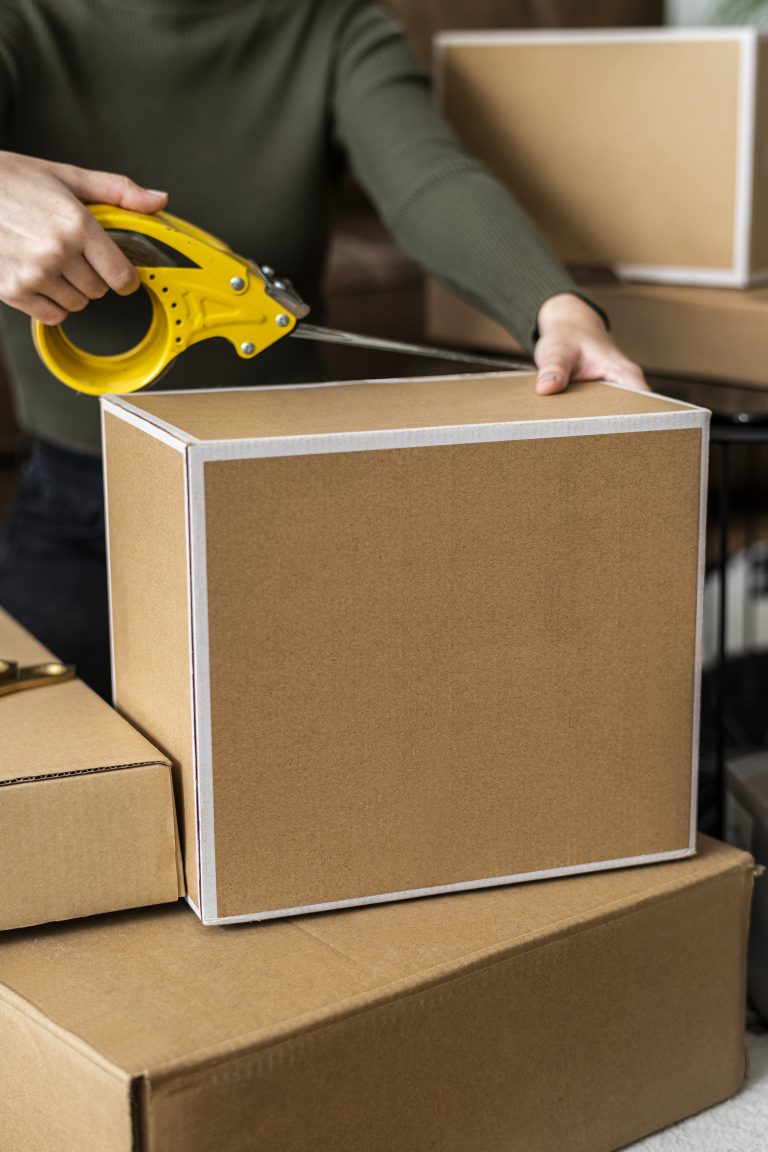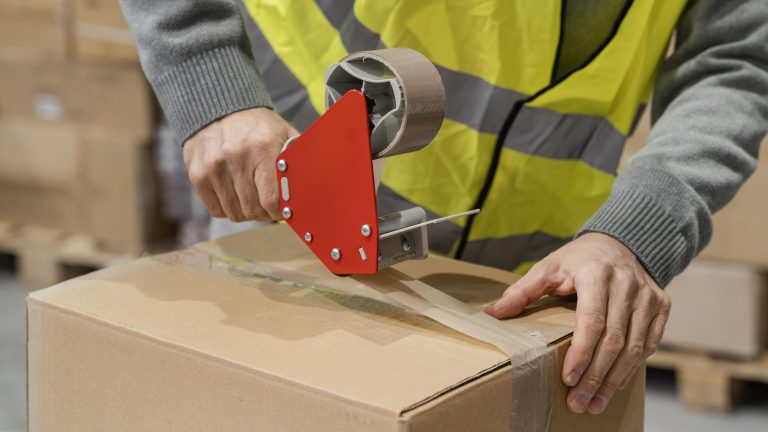
In the fast-paced world of material management, packaging and labeling play a crucial role in the overall supply chain strategy. From protecting products to enhancing brand visibility, effective packaging and labeling solutions help companies streamline operations, ensure compliance, and attract consumers. As we step into 2025, emerging technologies and sustainability goals are reshaping how businesses handle packaging and labeling.
Whether you’re a logistics manager, supply chain analyst, or a student pursuing a PGDM in material management, understanding the evolving landscape of packaging and labeling is vital. This blog explores the fundamentals of packaging and labeling, their importance in material management, and the latest trends in 2025. We’ll also touch upon how a Material Management Certification can equip professionals with the right skills to navigate these changes.

Understanding Packaging in Material Management
Packaging refers to the process of designing and producing containers or wrappings for a product. In the context of material management, packaging serves multiple purposes:
- Protection: Prevents damage during storage and transit.
- Storage Efficiency: Helps in the stacking and organization of materials.
- Identification: Ensures correct labeling and tracking through barcodes or QR codes.
- Regulatory Compliance: Adheres to legal and safety standards.
- Customer Experience: Enhances brand appeal and user experience.
Effective packaging ensures that products reach their destination safely, economically, and with minimal environmental impact.
What is labeling in material management?
Labeling refers to the use of textual and graphical information on packages to provide essential details about the product.
This includes:
- Product name and description
- Manufacturing and expiry dates
- Batch numbers
- Handling instructions
- Barcodes and QR codes
- Regulatory symbols and certifications
In material management, labeling aids in inventory control, tracking, and traceability. It ensures accuracy in dispatch, minimizes errors, and helps meet compliance requirements across industries.

The Importance of Packaging and Labeling in Material Management
Whether you’re working in pharmaceuticals, retail, or FMCG, packaging and labeling are integral to material management strategies.
Here’s why:
1. Inventory Accuracy
Well-labeled packages ensure correct inventory logging and real-time updates, reducing chances of mismatches and errors.
2. Operational Efficiency
Standardized packaging reduces handling time and improves warehouse efficiency. It also simplifies shipping and receiving processes.
3. Regulatory Compliance
Industries like food and healthcare require strict adherence to labeling laws. Non-compliance can lead to heavy penalties and product recalls.
4. Sustainability Goals
Eco-friendly packaging solutions reduce environmental impact and contribute to a company’s corporate social responsibility (CSR) goals.
Latest Packaging and Labeling Trends in 2025
As we look ahead, 2025 brings exciting innovations and shifts in the way companies approach packaging and labeling. Let’s explore the key trends shaping the industry:
1. Smart Packaging and IoT Integration
Smart packaging uses technologies like NFC (Near Field Communication), QR codes, and RFID tags to enhance traceability, provide real-time updates, and improve customer engagement. This technology is particularly beneficial in the pharmaceutical and food industries, where tracking conditions like temperature and humidity is crucial.
Benefits:
- Enhanced product safety
- Interactive consumer experiences
- Real-time inventory management
2. Sustainable and Biodegradable Packaging
Eco-conscious consumers and stricter regulations are driving companies toward sustainable packaging materials such as
- Plant-based plastics
- Recycled paper and cardboard
- Biodegradable films
Reducing plastic usage and adopting circular economy models is no longer a choice—it’s a necessity in 2025.
3. Minimalist and Functional Design
Modern packaging focuses on clean, minimalist aesthetics while maximizing functionality. The goal is to reduce packaging waste while maintaining brand visibility and user-friendliness.
4. AI-Powered Labeling Software
Artificial intelligence is revolutionizing the labeling process by:
- Automatically generating compliant labels
- Translating labels for global markets
- Integrating with ERP systems for accuracy
This trend helps streamline large-scale operations and minimize human errors.
5. Customization and Personalization
Brands are investing in personalized packaging to create a more engaging customer experience. Custom labels for special editions, regional preferences, or user demographics are becoming the norm.
6. Tamper-Proof and Secure Packaging
With the rise in counterfeit products, especially in pharma and luxury goods, tamper-evident and secure packaging solutions are trending. Holograms, security seals, and blockchain-based authentication are enhancing trust and safety.
7. Augmented Reality (AR) on Labels
In 2025, AR-integrated labels allow consumers to scan the product and view interactive content such as tutorials, brand stories, or virtual try-ons—bridging the gap between physical and digital experiences.

Why Learn About Packaging and Labeling?
Whether you are a working professional or a student pursuing a PGDM in material management, understanding packaging and labeling is critical for success. Companies are searching for individuals who are not just operationally sound but also tech-savvy and innovation-driven.
By investing in a Material Management Certification, you gain expertise in modern supply chain tools, technologies, and practices, including
- Sustainable material sourcing
- Lean inventory techniques
- Smart packaging systems
- Barcode and RFID labeling
- ERP and warehouse management systems
This makes you job-ready for roles such as supply chain manager, inventory analyst, packaging specialist, and logistics consultant.
How a PGDM in Material Management Helps You Stay Ahead
A PGDM in Material Management equips you with a broad understanding of procurement, logistics, packaging, warehousing, and inventory control. It’s a comprehensive program that combines theoretical insights with practical applications.
Key Takeaways from the Program:
- In-depth knowledge of material flow across supply chains
- Hands-on experience with labeling and tracking systems
- Exposure to global trends in packaging technology
- Learning through case studies and real-world scenarios
- Career opportunities in manufacturing, e-commerce, healthcare, and logistics
This program also emphasizes digital transformation in material management, including how AI, IoT, and automation impact packaging and labeling processes.
Career Opportunities in Packaging and Labeling
Professionals skilled in packaging and labeling are in high demand across various sectors:
- FMCG—Brand packaging, sustainable material innovations
- Pharmaceuticals—Regulatory labeling, tamper-proof design
- E-commerce—Smart packaging for delivery optimization
- Retail—Shelf-ready packaging and promotional labeling
- Automotive—Heavy-duty and export packaging
With a Material Management Certification or PGDM, you’re better positioned to lead packaging innovations, implement cost-effective solutions, and contribute to a greener, more efficient supply chain.
Conclusion
In 2025, packaging and labeling are not just about boxes and tags—they are about technology, sustainability, efficiency, and branding. As global supply chains grow more complex, the need for skilled professionals in material management is at an all-time high.
Whether you’re exploring a PGDM in Material Management or looking to upgrade your skills with a Material Management Certification, focusing on modern packaging and labeling trends will set you apart in the competitive job market. From AI-powered labeling to sustainable packaging solutions, the future is dynamic—and now is the time to be part of it.


